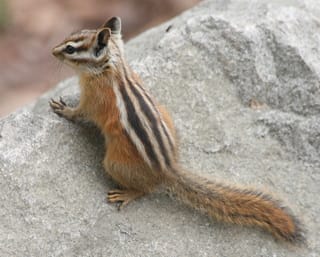This guide initially displays all common mammals. Use the selectors below to view mammals of a particular shape, include rare mammals, or search for them by name.
Mammals are defined as warm-blooded vertebrates with hair or fur and sweat glands — in the females mammary glands, modified sweat glands, produce milk to nourish the young. Most mammals develop a placenta which enables the feeding of the fetus during gestation and give birth to live young. In addition, although most mammals walk on land, many have specific adaptations that allow them to swim, fly, leap between tree branches or even dig extensive tunnels. Many wild mammals are used for both food and fur. while other have been domesticated for their agricultural and scientific importance.
New Mexico ranks high for mammalian diversity in the states in the US and the Pajarito Plateau is home to many of these species. This guide describes all of the larger wildlife found in the area as well as the more common smaller animals with the most abundant being rodents. Local species range from carnivores like the mountain lion and bobcat to ruminants like elk and deer to to several varieties of bats.
Mammal References
Biota Information System of New Mexico
Bogen et al. 1998 Continued Studies of Bat Species of Concern in the Jemez Mountains, New Mexico [PDF]
eNature
Frey et al. 2006 Checklist of New Mexico Mammals [PDF]
New Mexico Tech Mammalian Field Guide
Smithsonian National Museum of Natural History North American Mammals
Threatened, Endangered and Sensitive Species Profile – Los Alamos Laboratory Lands [PDF]
Tyrell and Brack 1992 Survey for Bats in the Los Alamos National Environmental Research Park
Subject Area Experts (all guides)
Steve Cary (butterflies)
Beth Cortright (insects)
Terry Foxx (invasive plants)
Leslie Hansen (mammals)
Richard Hansen (fish, mammals)
Dorothy Hoard (butterflies, trees)
Chick Keller (flowers, herbarium)
Shari Kelley (geology)
Kirt Kempter (geology)
Garth Tietjen (reptiles)
David Yeamans (birds)
Web Development and Content Management
Pat Bacha
Jennifer Macke
Graham Mark
Akkana Peck
Contact
Please contact us for local nature questions and sightings. We welcome comments, corrections, and additions to our guides.
For more information about local nature, please visit our Nature Blog or subscribe to PEEC This Week.
Make Selection
 Photo: J. N. Stuart |  Colorado Chipmunk(Tamias quadrivittatus, Neotamias quadrivittatus)Family: Sciuridae (Squirrels, Chipmunks, Marmots, and Prairie Dogs) Size: 8.1 - 9.4 in (21 - 24 cm) Status: native; common Habitat: pine forests, alpine and subalpine habitats, prairies, shrub and brushlands, prefers higher elevations Typical location: Los Alamos The Colorado Chipmunk is larger than the Least Chipmunk and when it vocalizes it sways its tail side-to-side rather than up-and-down like the Least Chipmunk. Colorado Chipmunks are territorial and solitary except during the breeding season. They feed on a variety of plant materials and potentially insects. They will collect food in autumn to cache for winter. Although, these chipmunks do climb trees they are primarily ground dwellers often living in rocky areas in burrows. Tracks Info Photos Distribution |
 Photo: Phil Armitage |  Least Chipmunk(Tamias minimus, Neotamias minimus)Family: Sciuridae (Squirrels, Chipmunks, Marmots, and Prairie Dogs) Size: 6.6 - 8.9 in (17 - 23 cm) Status: native; common Habitat: pastures, piney woods, rocky cliffs, coniferous forests, brushlands, prefers lower elevations Typical location: Los Alamos Tamias minimus is the smallest and most wide spread chipmunk species in North America. Least Chipmunks are diurnal and eat plant materials (seeds, berries, nuts and fruits) and insects. They often built and use nests in trees during the summer months. However, during the colder months they live in a simple burrow. They spend winter in a state of torpor, waking occasionally to eat food stored in the burrow or from nearby caches. The Least Chipmunk is very agile and communicates with a series of chipping sounds while flicking its tail up-and-down. Tracks Info Photos Distribution |
